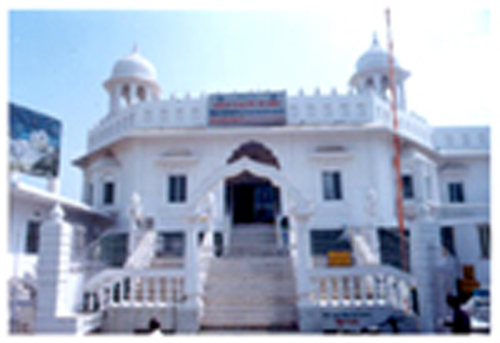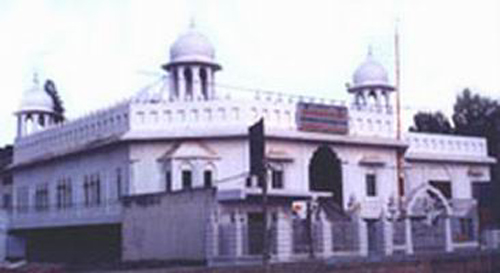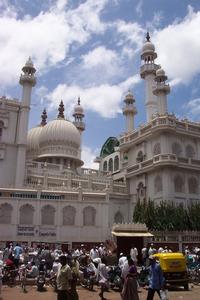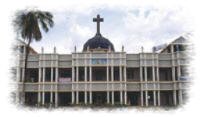SIKH
GURUDHWARA
 Near
the Ulsoor Lake stands the elegant and white Sikh Gurudwara. Opened on 13 April
1946, it is the main Sikh temple in Bangalore. Having been renovated recently,
the temple looks resplendent with marble floors.
Near
the Ulsoor Lake stands the elegant and white Sikh Gurudwara. Opened on 13 April
1946, it is the main Sikh temple in Bangalore. Having been renovated recently,
the temple looks resplendent with marble floors.
Devotees from all religions
and communities are welcome to the temple.The prayer hall is large and well-ventilated.
It can accommodate about 500 devotees at a time. Special prayers are offered every
Sunday and the temple wears a colourful look. Nearly a thousand people from all
religions come here to worship. Bhajans and kirtanas are sung in praise of Guru
Nanak and Guru Granth Sahib. After this, meals (vegetables, dal, chapatis and
payasam) are served to all.
 There
is a school, a medical centre and a function hall in the premises. The temple
also provides accommodation (a day's stay) to the tourists. The Sri Guru Singh
Sabha manages the affairs of the temple, but it is the devotees who sponsor free
medical consultancy and Sunday meals.
There
is a school, a medical centre and a function hall in the premises. The temple
also provides accommodation (a day's stay) to the tourists. The Sri Guru Singh
Sabha manages the affairs of the temple, but it is the devotees who sponsor free
medical consultancy and Sunday meals.
JUMMA
MASJID


The
most impressive mosque in Bangalore is Jamia Masjid, situated near City Market.
It dazzles in the sun with its exterior of pristine white marble from Rajasthan.
Rayyaz Asifuddin from Hyderabad designed it and the foundation stone was laid
by Sir Mirza Ismail (Dewan of Mysore) in 1940. Its balconies are exquisitely fashioned
with jali work.
It
is a five-storeyed structure, which can accommodate up to 10,000 worshippers.
The atmosphere inside the mosque is cool, serene and airy, with an ablution pool
in the centre. However the oldest mosque in the city is the Jumma Masjid at Cantonment
area, which is a brick and mortar structure with ornate jali-work and floral motifs
in plaster on the facade. It is located on Old Poor House Road and was once called
the Sangian Jamia Masjid. Granite pillars adorn the raised prayer hall of the
mosque
Tawakkal
Mastan
This
is probably the first dargah to be associated with a Hindu festival. The dargah
honours the Sufi saint, Hazrat Tawakkal Mastan. Legend has it that that the saint
was a mason from Arabia who was involved in the construction of Haidar's fort.
He had the misfortune of being trampled on by a crowd during a karaga procession.
It is said that he fainted and was revived by some priests who applied kum-kum
on his wounds, which is what was supposed to have healed him. He then insisted
that the procession stop at the dargah every time. It is situated in Cottonpet
and also has a marriage hall and a school.
St Patricks
Church This
is one of the oldest churches in the city (around 150 years old). Located on Brigade
road, this church was consecrated as a cathedral in 1899. Father Chevalier was
responsible for building this church, which boasts of a lovely arched entrance
flanked by twin columns. Twelve pillars symbolising the twelve apostles add grace
to the interiors of the church. The Church is a prestigious one being an important
place for worship and weddings.
People
who have grown up in Bangalore are aware of St Patrick's Church on Residency Road,
recognizeable by its twin spires. The services held on a Sunday morning were interesting
not so much for the priests homily but for the swallows that flew around the interior
of the church, quite unmindful of the congregation seated within.
Infant Jesus Church at Vivek
Nagar
 The
Church has a long history of sacrifice and devotion from the time it was first
conceived by Fr Paul Kinatukara in the sixties. In April 1970, the foundation
was laid by Rev.Dr.Lourduswamy, the then Archbishop of Bangalore, with absolutely
nothing to get started.It was Fr. L. Peter who set out on a daunting mission to
establish the church on a firm footing. Persisting faith and courage prevailed
and finally the present church was opened in the year 1979, despite gruelling
obstacles. The most noticeable feature of the church is the secular nature of
the devotees.
The
Church has a long history of sacrifice and devotion from the time it was first
conceived by Fr Paul Kinatukara in the sixties. In April 1970, the foundation
was laid by Rev.Dr.Lourduswamy, the then Archbishop of Bangalore, with absolutely
nothing to get started.It was Fr. L. Peter who set out on a daunting mission to
establish the church on a firm footing. Persisting faith and courage prevailed
and finally the present church was opened in the year 1979, despite gruelling
obstacles. The most noticeable feature of the church is the secular nature of
the devotees.
The
Infant Jesus Church was recently rebuilt making it the biggest church in Karnataka.
The newly built Church, a popular pilgrimage centre at Viveknagar in Bangalore
was on inaugurated by Dr Bernard Moras, Archbishop of Bangalore on June 10, 2005.
Representative
of the Vatican in India Dr Pedro Lopez Quintana dedicated the new church at a
Eucharistic celebration.
In
terms of accommodating the number of people, this is the largest church in Karnataka.
With 312 benches, it can seat about 3,500 persons inside the worship hall and
another 5,000 people in the open podium area.
St.
Mary's Basilica
A
small chapel was the original structure built by Abbe Dubois, French missionary.
This chapel is right opposite the Russel Market Square. The interior is remarkable,
with stained glass windows and multiple columns with a rich Corinthian capital
supporting the stately arches. Many devotees dressed in orange, gather here to
celebrate St Mary's Feast in September every year. A papal order from Pope John
Paul VI gave the church the status of a Basilica in 1973. If you seek the Mother
Mary's blessings then visit the church on Saturday. The present structure was
built in 1875-1882.
St.
Andrew's Kirk
The
only Scottish Kirk in Bangalore, situated on Cubon Road parallel to MG Road contains
stained glass windows depicting Lord Jesus and his eight apostles. A pipe organ
was also installed here in 1881. The walls are adorned with polished brass plaques.
There is also a plaque of John Cook, the Principal of Central College in Bangalore
in 1915.
Holy
Trinity Church
This
beautiful landmark at the east end of the M.G. Road was built in 1848-51. It is
built in the English Renaissance style.The church can accommodate 700 people and
is regarded as the largest "military" church in Southern India.



